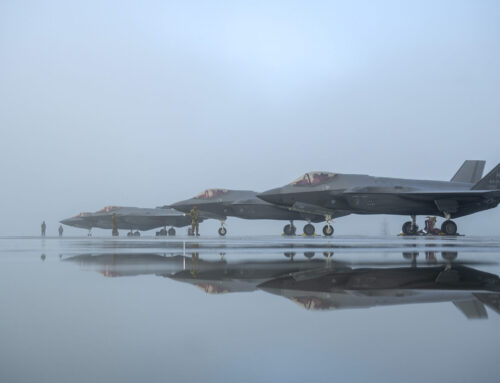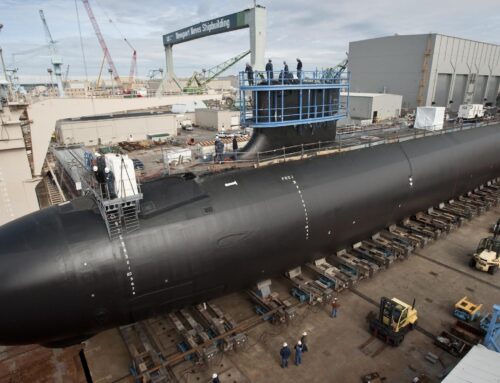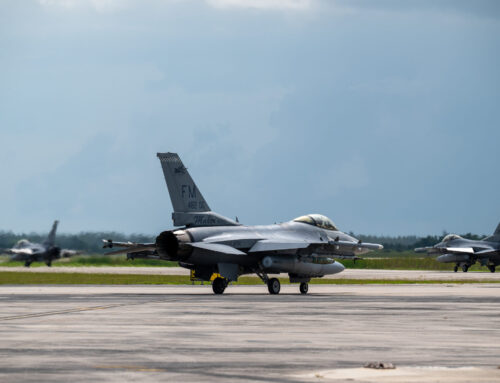Chief of Naval Operations Adm. Lisa Franchetti participates in a wreath laying ceremony at the Anitkabir – Atatürk Mausoleum, in Ankara, Türkiye, June 3, 2024. (US Navy photo by Chief Mass Communication Specialist Amanda Gray)
WASHINGTON — The Navy’s top officer today released a new Navigation Plan, placing the service’s strategic focus squarely on preparing for a future conflict with China, potentially within the next few years.
“The challenge posed by the [People’s Republic of China] to our Navy now goes well beyond just the size of the PLA Navy fleet. Ships matter greatly but gone are the days when we assessed threats based purely on the number of battle force ships or tonnage,” Chief of Naval Operations Adm. Lisa Franchetti wrote in the new document, published today.
“Through operational concepts like multi-domain precision warfare, grey zone and economic campaigns, expansion of dual use infrastructure (e.g., airfields) and dual use forces (e.g., Chinese maritime militia), and a growing nuclear arsenal, the PRC presents a complex multi-domain and multi-axis threat.”
The “Navigation Plan,” or NAVPLAN, is an overarching strategic document routinely published by the Navy’s top admiral. (Prior to today, the most recent NAVPLAN was published in July 2022.) Similar to the Marine Corps’ Commandant’s Planning Guidance, the document provides an outlet for the Navy’s top officer to share their vision for the future with the fleet.
Franchetti’s new NAVPLAN is heavily focused on the 2027 timeline that Chinese leadership have said they’ve given to their military to be prepared for a conflict — likely over the status quo of Taiwan — with the United States or any American allies who might intercede. It highlights long-range fires, non-traditional sea denial, counter C5ISRT, terminal defense and contested logistics as “key capabilities.”
An integral part of the Navy’s efforts to counter China will be what the CNO has dubbed “Project 33.” (Thirty-three alludes to the fact Franchetti is the 33rd officer to serve as the chief of naval operations.)
Key aspects of Project 33 include eliminating ship, submarine and aircraft maintenance delays; scaling the use and integration of robotic and autonomous systems; boosting recruitment and retention; and “train[ing] for combat as we plan to fight, in the real world and virtually.”
Franchetti’s document also alludes to the financial pressures the Navy is under and how the service will “eventually face deep strategic constraints” on its ability to simultaneously conduct daily operations and invest in future modernization short of any budgetary boost.
“This 2024 Navigation Plan reflects our current emphasis on readiness and capability considering near-term budgetary and industrial realities, while continuing to advocate for the resources needed to expand all aspects of the Navy’s force structure necessary to preserve the peace, respond in crisis, and win decisively in war,” she wrote.
The document also makes a lesser mention of Russia, stating the “wounded and isolated” country “remains dangerous,” as well as the ongoing attacks by Hamas and the Houthis in the Middle East.
“Moscow, Beijing, Tehran, and Pyongyang have strengthened their linkages and are actively targeting the U.S., our allies, and our partners in the information domain,” the document said. “Damage to undersea pipelines and cables underscored how seabed infrastructure has become targetable.”
The NAVPLAN sets several goals for the larger service and designates a “single accountable official” for each target with a 2027 deadline.
The vice chief of naval operations for example will “achieve and sustain an 80 percent combat surge ready posture for ships, submarines and aircraft.” The service’s top requirements officer, also called the N9, will integrate robotics and autonomous systems for “routine use” by operational commanders, according to the document.
“We must meet all the objectives in this Navigation Plan to field the people and capabilities needed to fight and win today, in 2027, and beyond,” Franchetti wrote. “As we accelerate where possible, we will also continue the crucial work already underway to enhance the critical capabilities and enablers laid out in prior Navy guidance.”











